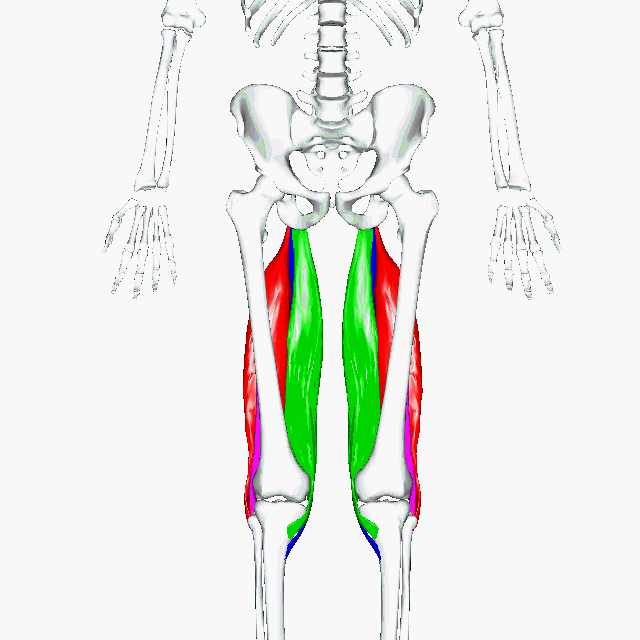Semitendinosus & Semimembranosus
My hamstrings are sooooo sore. I just finished a killer Icelandic Crossfit workout where we did about a million power cleans. Apparently my hamstrings are my weak link in this lift. I was far inferior. The men were massive and the women all looked like super models. Seriously, if you ever get the chance to go to Crossfit Reykjavik then go. Your jaw will hit the floor.
Butt, back to hamstrings. As stated, these are my weak link in my posterior chain. Of course, the posterior chain of muscles include all those that help us stand upright. Think of bending over with knees bent, gripping that barbell, right before you go into a clean (as you try to keep up with the stunning Icelandic blonde bombshell on your right). All those muscle that must shorten to extend your hips and straighten your back and pull the bar up to the top of your chest (hamstrings, glutes, erector spinae, traps and rear delts) are those of the posterior chain. Today mine is sore, particularly the hamstrings.
FORM & FUNCTION
Mostly when we think of the hamstring muscles we think of knee flexors and maybe those ridiculous machines you see at the gym made for you to sit or lie down and flex the knees. Please, don't do this! Talk about the most unnatural movement you can do while in the gym. When would you ever do this in real life??? Never. I suppose it does cause the hamstring muscle to contract flexing the knee but this group of muscles is far more complex than that. The hamstrings cross two joints not one. Therefore, to properly train them you need to move both joints, the hip and the knee. The 3 muscle that make up the hamstrings include the semitendinosus, semimebranosus, and the biceps femoris.
As you can see from the images below they originate way up at the ischeal tuberosity. This is your sit bone, behind your hips. They then extend down beyond the knee to the top of the lower leg bones, the tibia and fibula. This means that full contraction leads to hip extension as well as knee flexion, but why would this be helpful? Extending one joint while flexing another?
Think of a sprinter. Usain Bolt's toe touches the ground and with incredible power he pulls himself forward with knee flexion and propels himself towards another world record with hip extension. This is an essential part of human movement. Running requires the coordination of these joints, best executed by the hamstring muscles. What a beautiful thing really. The simultaneous pulling and pushing. Joint movements flowing together in amazing synchronicity to produce the running stride. It is a sight to behold and yet it only takes a few years from toddler to child to develop the all out sprint.
EXERCISE
There are no specific movements necessary to develop the semitendinosus and semimebranosus who insert on the inner aspect of the knee (just reach your hand down and feel these two tendons) over the biceps femoris which connects to the fibula on the outer posterior aspect of the knee (feeling laterally you will only feel one tendon behind the knee). All are exercised best as already mentioned above, hip extension and knee flexion. It just so happens running is about the only time you are really performing these actions at the same time so sprints are your best hamstring workout. These long, lean muscles are great at rapidly contracting to flex the knee and then extend the hip. Look at the sprinters above basically kicking their own butts with their exaggerated hamstring flexion. So warm up with butt kicks and go to high knees and all-out sprint to really work the hamstrings.
Other movements in the gym can target the hamstrings but rarely do knee flexion and hip extension. I've already said I hate the hamstring curls because they are so unnatural. Never will you have your heel loaded with weight to perform a movement in athletics. Instead, keep your feet on the floor (or at least start on the floor) to complete some great hamstring workouts. Anything that also engages the glutes, particularly fast-moving motions that are akin to sprinting, is good for hamstring training. This includes virtually every Olympic lift as they all start on the floor with hips flexed and depend on a rapid and strong hip extension to accelerate the weight. Deadlifts are a slow-motion version of this that asks the hamstrings to contribute, but as I learned, power cleans are a great way to get the hamstrings to contract rapidly (hip extension) while I quickly try to get under it (knee flexion) to catch the weight on my chest.
Give that a try and if you're not sore, just fly to Iceland for some real CrossFit, and you'll sure to be sore in the morning. Don't believe me? Check out this article on The Importance of Developing a Strong Posterior Chain for CrossFit and watch the video below.







